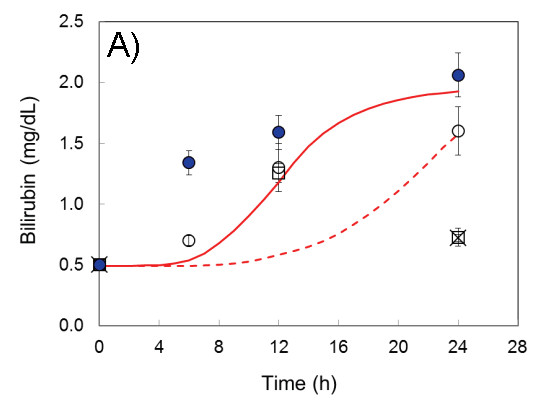Examining Hy's Law
Formalizing the available literature related to DILI for the DILIsym® modeling software has itself provided insights into the biology. For example, the modeling team sought to examine Hy’s Law, which specifies liver injury concerns in subjects with simultaneous elevations of ALT exceeding three times the upper limit of normal (ULN) and of bilirubin exceeding twice the ULN. Bilirubin is inversely correlated with viable hepatocyte numbers (Portmann et al., 1975), but in some cases bilirubin is elevated before liver necrosis is apparent (Pooranaperundevi et al., 2010a, 2010b; Sawant et al., 2004; Zieve et al., 1985), suggesting that hepatocyte death may not be the primary mechanism underlying early increases in bilirubin. Alternate mechanisms for drug-induced loss of hepatocellular function were investigated.
While analyzing this data, we observed an inverse correlation between GSH and bilirubin following drug administration (Sawant et al., 2004; Pooranaperundevi et al., 2010a, 2010b), and there were data showing a direct correlation between hepatic GSH and ATP levels (Jenner and Timbrell, 1994). Together, these data supported the hypothesis that drug-induced bilirubin elevation might initially result from a decrease in hepatocellular ATP. The hypothesis is further supported by examination of the requirements for bilirubin processing, which includes several steps that are likely ATP-dependent, e.g., bilirubin conjugation and export from the hepatocyte (Tiribelli and Ostrow, 1996; Borst et al., 2007; Paulusma et al., 1997). Using the DILIsym® software, APAP was simulated in the presence or absence of an ATP contribution to bilirubin generation. The results, shown in the figure below, demonstrate that the addition of an ATP effect more faithfully reproduces experimental data on drug-induced early bilirubin elevation than drug-induced hepatocyte death alone.
In terms of Hy's Law, these results support the idea that early bilirubin elevations may be a mechanistic biomarker for hepatocellular energetic disruptions, which could explain the strong correlation between Hy's Law cases and drugs that are likely to cause DILI when introduced to the general population. This example illustrates the integration of multiple datasets and how it supports the formulation of new hypotheses that better reconcile the data.
